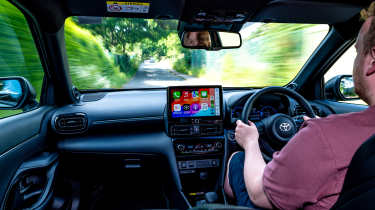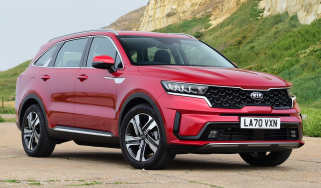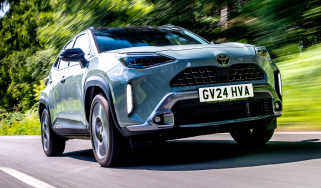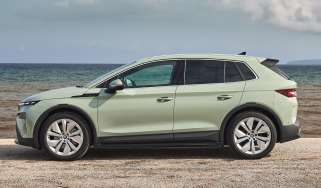Toyota Yaris Cross review
The Toyota Yaris Cross is a sensible, efficient, and appealing small SUV

Is the Toyota Yaris Cross a good car?
The Toyota Yaris Cross delivers where it matters most for buyers considering a small SUV. Of course, there’s the benefit of the higher driving position with better visibility, and slightly more practicality than the Yaris supermini upon which it is based, but the Yaris Cross is also competitively priced compared to its rivals, is easy to pilot around town and offers excellent real-world economy courtesy of its efficient hybrid system.
Yes, it feels like Toyota’s bean counters have had the last word in certain areas of the cabin, and some of its rivals are better for rear space. However, it’s a good-looking little car offering a generous level of standard kit and a recent round of updates has brought benefits up and down the range, including bigger touchscreens. Plus buyers on a budget needn’t worry because overall running costs should be pretty low.
Our choice: Toyota Yaris Cross Hybrid Design
| Key specs | |
| Fuel type | Petrol hybrid |
| Body style | Small SUV |
| Powertrain | 1.5-litre 3cyl petrol plus 1x e-motor, front-wheel drive 1.5-litre 3cyl petrol plus 2x e-motor, four-wheel drive |
| Safety | 5-star Euro NCAP (2021) |
| Warranty | 3yrs/60k miles (up to 10yrs/100k miles with routine franchised dealer servicing) |
Toyota Yaris Cross: price, specs and rivals
The Toyota Yaris Cross is the Japanese brand’s entry into the jam-packed small SUV segment, and starts from £26,000 in entry-level Icon trim. Our preferred Design trim costs around £29,000, while the top-of-the-range Premiere Edition with four-wheel drive and the more potent 128bhp engine tops out at just over £35,500.
More reviews
Car group tests
In-depth reviews
Road tests
As the name suggests, it’s based on the regular Toyota Yaris and uses the same 'self-charging hybrid' technology as the frugal little supermini, which is at its best when driving in and around town, on shorter, urban commutes or competing in the hustle and bustle typical of the daily school run.
Since its introduction three years ago, the Yaris Cross has been a smash hit across Europe – even by small SUV standards, which generally fly out of showrooms faster than Marvel releases new superhero movies. More than 180,000 examples were sold in 2023 alone, nearly 20,000 of which found homes in the UK.
Toyota clearly didn’t want to mess with that success when upgrading the Yaris Cross for 2024, because rather than a wholesale facelift, the brand focused on a few carefully selected improvements. This is a bold move, especially considering many key rivals have recently received significant overhauls.
There are some all-electric alternatives too, but not everyone can install a wallbox charger or have public chargers nearby where they live. This is why a full-hybrid is a fine middle ground between pure-petrol and EVs. Such a system can drive the car for short distances using electric power alone, but it doesn’t get electricity from a plug socket. Instead, energy is recuperated during braking, or when the engine doesn’t need to provide all its power to the wheels to drive the car. The end result is a smooth driving experience in town, and impressive fuel economy.
Every Yaris Cross features a 1.5-litre three-cylinder petrol engine under the bonnet, plus an electric motor to drive the front wheels. Most models offer a combined output of 114bhp and 141Nm of torque, however, top-spec cars now boast a more powerful setup with 129bhp and 185Nm on tap.
A CVT automatic transmission is standard throughout the range, with no manual gearbox available. However, buyers can upgrade to all-wheel drive, or ‘AWD-i’ as Toyota calls it, which adds another small e-motor to the rear axle for extra traction in slippery conditions.
The entry-level Icon trim provides a decent level of kit, including 16-inch alloy wheels, a nine-inch touchscreen, wireless Apple CarPlay and Android Auto connectivity, a seven-inch instrument panel, adaptive cruise control, reversing camera and automatic air conditioning. Design, Excel, GR Sport and Premiere Edition specifications make up the rest of the range, and add features such as a 10.5-inch central display, 12.3-inch digital driver’s display, a wireless charging pad, a hands-free electric tailgate and larger alloy wheels.
Engines, performance & drive
It shouldn’t surprise you to read that a hybrid small SUV designed to be as efficient as possible is, on the whole, satisfying to drive rather than outright fun. For the latter, you’ll need a Ford Puma. It’s an easy car to pilot around town, very smooth, and generally quiet, thanks to its electric motor that allows it to trundle along in traffic without needing the engine. At higher speeds, thicker windscreen and side windows mean low wind noise, but there’s still plenty of tyre noise, making the Volkswagen T-Cross a better long-distance companion. Read more about the Toyota Yaris Cross' engines, performance and drive…
MPG, emissions & running costs
The Toyota Yaris Cross scores big points in terms of fuel efficiency with its hybrid-only engine line-up. This also helps with emissions, which are noticeably lower than its petrol-only or mild hybrid rivals. Insurance costs are towards the more affordable end of its class thanks to plenty of standard safety kit, plus its resale values either meet or exceed those of its competitors. Read more about the Toyota Yaris Cross' MPG, emissions and running costs…
Interior, design & technology
The exterior of the Toyota Yaris Cross has been designed to look more rugged with plenty of black plastic body cladding and neatly integrated roof rails from Design trim and above. The interior looks functional rather than luxurious, and we prefer the smaller infotainment screen sizes because these retain physical shortcut buttons. Read more about the Toyota Yaris Cross' interior, design and technology…
Boot space, comfort & practicality
While those sitting up front should find plenty of space in the Toyota Yaris Cross, the rear is a bit of a squeeze for adults, and might make fitting a bulky child seat difficult. The Yaris Cross lacks some of the clever practicality touches of its rivals, such as the sliding rear seats of the Renault Captur and VW T-Cross, while its boot is on the small side, and most models have a sizable loading lip to contend with. Read more about the Toyota Yaris Cross' boot space, comfort and practicality…
Reliability & safety
The Yaris Cross gained the maximum five-star safety rating from crash test experts Euro NCAP, scoring better than the four-star Peugeot 2008 and Vauxhall Mokka. There’s plenty of standard safety technology, while high-end versions add blind spot monitoring and a rear cross traffic alert system. The Toyota brand’s reputation for reliability is backed up by a manufacturer’s warranty that can be extended up until 10 years or 100,000 miles. Read more about the Toyota Yaris Cross’ reliability and safety…
Toyota Yaris Cross alternatives
The Toyota Yaris Cross will appeal to those who only occasionally need to put people in the back, and want a car that’s cheap to run in terms of fuel costs, insurance and depreciation. They’ll also value strong equipment levels with plenty of safety assistance technology. The Yaris Cross is a rarity in the small SUV class that can be had with four-wheel drive, which might be very useful to those who need the additional traction of four-wheel drive in slippery conditions.
It isn’t the most practical small SUV and misses out on some useful practicality features of its rivals, such as the sliding rear seats of a Renault Captur and Volkswagen T-Cross, which allow you to trade boot space for rear leg room if you have taller passengers, or the Megabox in the boot of the Ford Puma for some hidden underfloor storage. The Puma is also much nicer to drive than the Yaris Cross, with greater driver engagement.
There are also established rivals such as the Nissan Juke to consider, or the more premium-feeling Peugeot 2008. The latter can be had with a range of petrol, hybrid, or all-electric powertrains, just like the Hyundai Kona, Kia Niro, and Jeep Avenger.
Toyota Yaris Cross Design: long-term test
Back in 2022, our then news and reviews editor, James Brodie, enjoyed six months of highly economical motoring in a mid-range Toyota Yaris Cross Design. It did everything expected of it and didn’t throw up any surprises in several thousand miles of motoring.
That being said, James didn’t find it to be the most interesting of small SUVs out there, and he wasn’t all that impressed with rear seat accommodation, which could, he thought, be a bit of a problem for families.
Frequently Asked Questions
The Toyota Yaris Cross looks the part, is easy to pilot around town and offers excellent real-world fuel economy courtesy of its efficient hybrid system.












